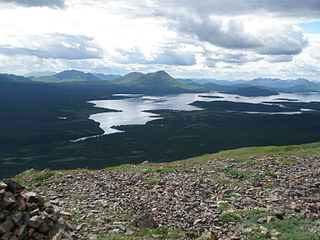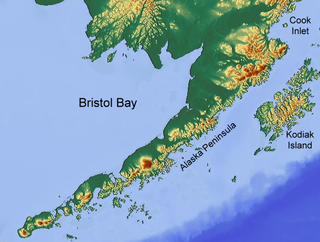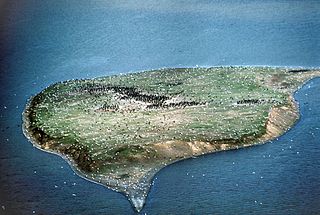

Nushagak was a trade center and settlement near the present-day site of Dillingham, Alaska, United States, at the northern end of Nushagak Bay in northern Bristol Bay. It was located near the confluence of the Wood River and Nushagak Rivers.


Nushagak was a trade center and settlement near the present-day site of Dillingham, Alaska, United States, at the northern end of Nushagak Bay in northern Bristol Bay. It was located near the confluence of the Wood River and Nushagak Rivers.




The area was inhabited by Yup'ik people and Athabaskan peoples. In 1818 Russians built the post of Alexandrovski Redoubt (Post) there. A Russian Orthodox mission was established there in 1837, by which time the community was known as Nushagak. Nushagak became a place where different Alaska Native groups from the Kuskokwim River, the Alaska Peninsula and Cook Inlet came to trade or live. [1]


In 1881, after the Alaska Purchase by the United States, the United States Signal Corps built a weather station at Nushagak. The first salmon cannery in the Bristol Bay region was constructed by Arctic Packing Company in 1883 at Kanulik, just east of Nushagak Point. Several other canneries followed, two of which were at Nushagak Point.

The Pacific Steam Whaling Company built a cannery there in 1899 with Crescent Porter Hale as its first superintendent. It was bought by Pacific Packing and Navigation Co in 1901 and after its demise, Northwestern Fisheries Co. in 1904. Pacific American Fisheries bought the property in 1933 along with others in the region but never operated the Nushagak cannery. It was leased to Lowes Trading Company in 1936 and closed after the 1937 season following death of Lowes' manager, Alex Bradford, and reports of financial difficulties. The second cannery built in 1899 was owned by the Alaska Fisherman's Packing Co. It was bought by Libby, McNeill and Libby in 1916 and operated until 1936.

Despite the commanding position that the Point offered over the entire upper Nushagak Bay, it suffered from extensive and growing mud flats that limited access to vessels except during the bay's extreme high tides. Nushagak Point remains the location of some productive salmon set net sites. Artifacts from the cannery era, such as donkey engines, still remain.
The world wide influenza pandemic of 1918 devastated the region in 1919, and contributed to the depopulation of Nushagak. After the epidemic a hospital and orphanage were established in Kanakanak, across the river and 6 miles (10 km) from the present-day city center of Dillingham.
| Census | Pop. | Note | %± |
|---|---|---|---|
| 1880 | 178 | — | |
| 1890 | 268 | 50.6% | |
| 1900 | 324 | 20.9% | |
| 1910 | 74 | −77.2% | |
| 1920 | 16 | −78.4% | |
| 1930 | 43 | 168.8% | |
| 1940 | 41 | −4.7% | |
| U.S. Decennial Census [2] | |||
Nushagak first reported on the 1880 U.S. Census as an unincorporated village (spelled "Nushegak" and with the alternative name of "Alexandrovsk.") [3] [4] It reported 178 residents, of which 91 were Inuit, 86 were Creole (Mixed Russian and Native) and 1 White. In 1890, it reported as Nushagak, which also included the weather station, Nushagak Cannery & Hunters Camp. [5] It had 268 residents, of which a plurality (99) were Asian (imported workers for the canneries), 85 were Natives, 64 were White and 20 were Creole.

In 1900, it reported 324 residents, but did not return the racial demographics. With the closure of the canneries, the population dropped precipitously. It did not report again after the 1940 census, though the Geographical Survey Professional Paper on Alaska reported an unofficial population of 7 in 1958.
Branson, John B. (2012). The Life and Times of John W. Clark of Nushagak, Alaska, 1846-1896 . Lake Clark National Park and Preserve. ISBN 9780979643262.

Aleknagik is a second class city in the Dillingham Census Area of the Unorganized Borough of the U.S. state of Alaska. The population was 219 at the 2010 census, down from 221 in 2000.

Dillingham, also known as Curyung, is a city in Dillingham Census Area, Alaska, United States. Incorporated in 1963, it is an important commercial fishing port on Nushagak Bay. As of the 2020 census, the population of the city was 2,249, down from 2,329 in 2010.
Ugashik is a census-designated place (CDP) in Lake and Peninsula Borough, Alaska, United States. The population was 4 at the 2020 census, down from 12 in 2010.

Hoonah is a largely Tlingit community on Chichagof Island, located in Alaska's panhandle in the southeast region of the state. It is 30 miles (48 km) west of Juneau, across the Alaskan Inside Passage. Hoonah is the only first-class city on Chichagof Island, the 109th-largest island in the world and the 5th-largest island in the U.S. At the 2020 census the population was 931, up from 760 in 2010. In the summer the population can swell to over 1,300 depending on fishing, boating, hiking and hunting conditions.

Petersburg is a census-designated place (CDP) in and essentially the borough seat of Petersburg Borough, Alaska, United States. The population was 3,043 at the 2020 census, up from 2,948 in 2010.

The District of Alaska was the federal government’s designation for Alaska from May 17, 1884, to August 24, 1912, when it became Alaska Territory. Previously (1867–1884) it had been known as the Department of Alaska, a military designation.

Bristol Bay is the easternmost arm of the Bering Sea, at 57° to 59° North 157° to 162° West in Southwest Alaska. Bristol Bay is 400 km (250 mi) long and 290 km (180 mi) wide at its mouth. A number of rivers flow into the bay, including the Cinder, Egegik, Igushik, Kvichak, Meshik, Nushagak, Naknek, Togiak, and Ugashik.

The Nushagak River is a river in southwest Alaska, United States. It begins in the Alaska Range and flows southwest 450 km (280 mi) to Nushagak Bay, an inlet of Bristol Bay, east of Dillingham, Alaska.
Ekuk is a small unincorporated community in the Dillingham Census Area in the U.S. state of Alaska. As of both the 2000 and 2010 U.S. Censuses, it had a population of 2. It is classified by the U.S. Census as an Alaska Native Village Statistical Area (ANVSA). Until 2002 it was the site of a large fish processing operation owned by Wards Cove Packing Company. Currently, it is inhabited mainly by seasonal fishing families who set gillnet in the nearby waters of the Nushagak Bay for mid-summer runs of sockeye salmon, early season runs of king salmon and late season runs of silver salmon.

Nushagak Bay is a large estuary covering over 100 km2 in southwest part of the U.S. state of Alaska. It opens to Bristol Bay, a large body of water in the eastern Bering Sea north of the Alaska Peninsula.

The Nushagak Peninsula is an uninhabited peninsula in the U.S. state of Alaska. It is situated in the Dillingham Census Area, west of the Alaska Peninsula. The 520,000 acres (210,000 ha) byland measures 35 by 15 miles. It was named for Nushagak Bay in 1910 by the United States Coast and Geodetic Survey. With a large area of lakes, ponds and tidal sloughs, the peninsula contains the biggest complex of wetlands of the Togiak National Wildlife Refuge.

Southwest Alaska is a region of the U.S. state of Alaska. The area is not exactly defined by any governmental administrative region(s); nor does it always have a clear geographic boundary.

The Egegik River is a waterway in the U.S. state of Alaska. A biological survey was conducted at the base of the Alaska Peninsula in 1902 by Wilfred Hudson Osgood, which included the Egegik River.

The Alaska Packers' Association (APA) was a San Francisco-based manufacturer of Alaska canned salmon founded in 1891 and sold in 1982. As the largest salmon packer in Alaska, the member canneries of APA were active in local affairs, and had considerable political influence. The Alaska Packers' Association is best known for operating the "Star Fleet," the last fleet of commercial sailing vessels on the West Coast of North America, as late as 1927.
Taku Harbor is a small, remote bay located on the eastern shore of Stephens Passage about 22 miles (35 km) southeast of central Juneau, Alaska, United States.
Crescent Porter Hale (1872–1937) was an American industrialist who was involved in the canned salmon industry in Bristol Bay, Alaska throughout his adult life.

Pacific Packing and Navigation Company is a defunct salmon-canning company which operated in the U.S. state of Alaska. Incorporated under the laws of New Jersey and backed by eastern capitalists, it was formed during the spring of 1901, the idea of Roland B. Onnfroy. It consolidate into one corporation the properties and privileges of other Alaska companies and firms. It proposed to capitalize the new corporation as follows: 6 per cent debentures, $7,000,000; 7 per cent cumulative preferred stock, $12,500,000; common stock, $12,500,000.

Wood River is a waterway in Alaska as well as a location outside Dillingham, Alaska by Wood River Road and the Wood River. The Wood River Lakes Trail is used for backcountry float trips. The Wood River Mountains are nearby. Wood River Road is one of the areas transportation routes. The rivers source is the Aleknagik Lake. The river runs past Dillingham where it meets the Nushagak River and enters Nushagak Bay. Nushagak was a former trading post by the area where the rivers met.
Sacramento, California, United States, has been an important location in the history of canning thanks to its situation on the intersection of major transportation routes and proximity to large fertile growing areas. Sacramento’s canning industry has prepared a large variety of agricultural products, but is best known for canned tomatoes, earning Sacramento the nickname, "The Big Tomato."
Nikola Bezmalinovic, known as Nick Bez was founder of fishing, canning, and shipping companies in Juneau, Alaska. Nick Bez operated the largest fishing ship at the time the 423-foot, Pacific Explorer. Nick Bez also owned and operated the Nornek cannery, two gold mines, Alaska Southern Packing Company, Peter Pan Seafoods, Alaska Southern Airways, Pacific Exploration Company and the Intercoastal Packing Company as well as West Coast Airlines which became part of Air West. Nick Bez became known as a rags to riches entrepreneur. In 1919 Nikola Bezmalinovic changed his name to Nick Bez. Nick Bez died in 1969.